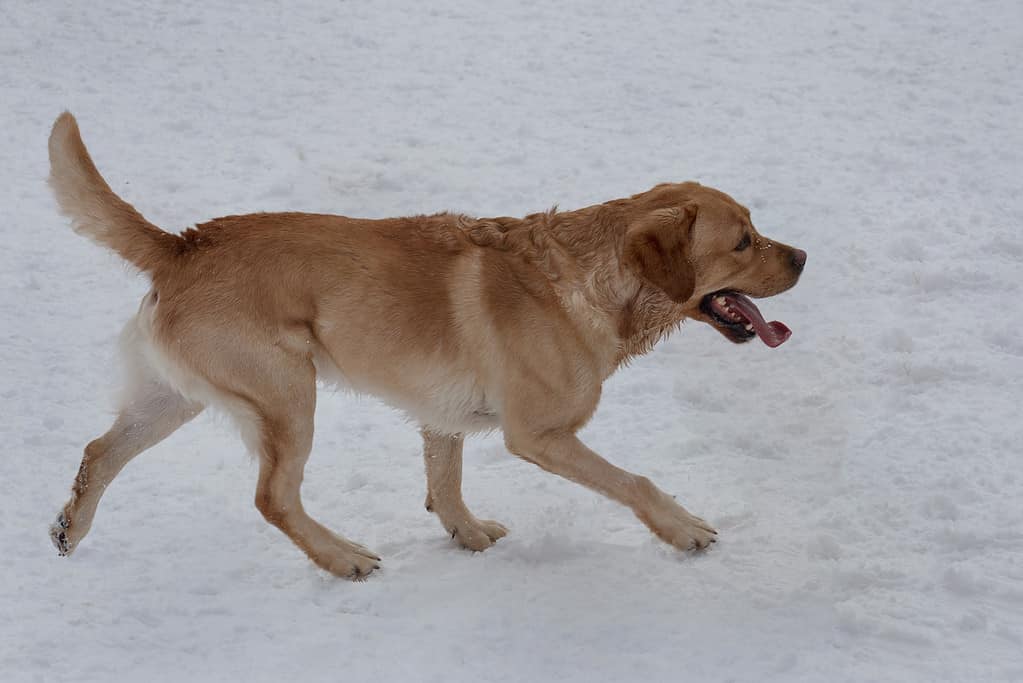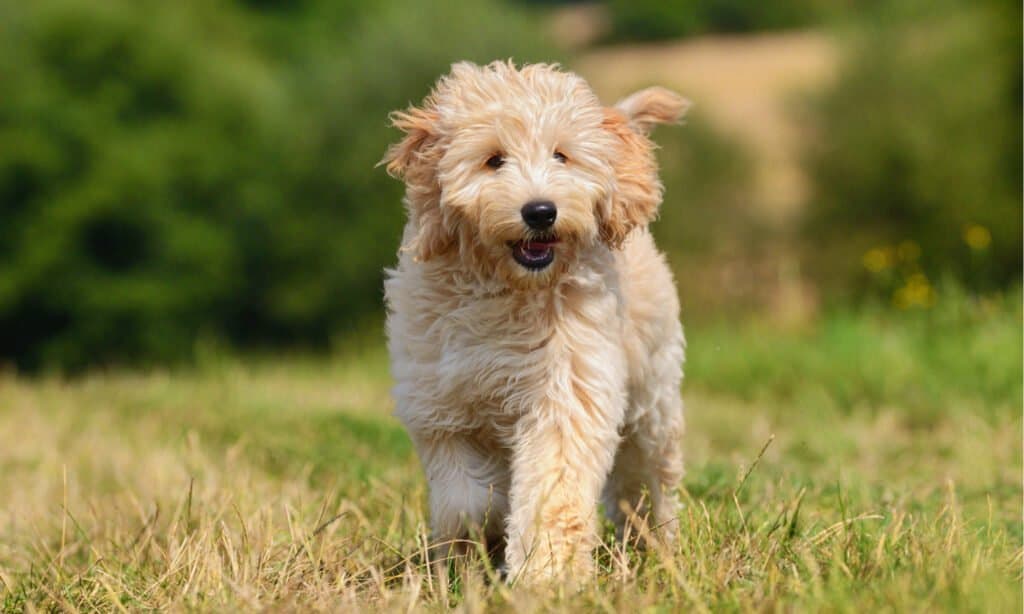Golden retrievers are popular for their friendliness, humor, and trainability. These dogs make a great addition to the family! But you might wonder about the different types of goldens and how they vary.
The three types of golden retrievers are the American goldens, British goldens, and Canadian goldens. They vary only slightly in appearance and are bred according to each country’s kennel club standards. There are also field goldens and show goldens, which are bred for hunting and showing respectively.
In this article, we’ll discuss the differences and similarities between these golden retriever types, some false types, and more about this popular breed!
1. American Goldens

These dogs have deep golden coats that are rich in color.
©Evgeniy Negrey/Shutterstock.com
When you picture a golden retriever, you’re likely thinking of the American golden. These dogs have deep golden coats that are rich in color. In fact, the breed standard faults light-colored coats.
Their coats are thick and long, with feathering on the belly, legs, and tail. They also have long fur on their necks.
They may have lighter colored eyes than other goldens.
American goldens stand 21.5-24 inches at the shoulder and weigh 55-75 pounds.
2. British Goldens

In appearance, English goldens are more muscular than Americans or Canadians. Their bodies and muzzle are wide.
©Chendongshan/Shutterstock.com
British goldens, also known as English goldens, follow the British Kennel Club breed standards, which are only slightly different from the American and Canadian standards.
They’re typically lighter in color, and unlike the others, can be a light cream. This shade is often referred to as English cream.
They tend to weigh the most out of the three, though the breed standard doesn’t specify a weight range. In appearance, English goldens are more muscular than Americans or Canadians. Their bodies and muzzle are wide.
They’re nearly the same size as American goldens but stand slightly shorter at 20-24 inches.
Like Americans, they have long, dense fur and lots of feathering.
3. Canadian Goldens

These pups tend to have big heads and their ears are set further back than the others on this list.
©Tikhomirov Sergey/Shutterstock.com
Canadian goldens also have long, dense, feathered coats. Although some claim they have shorter fur, this isn’t true according to the Canadian breed standard.
These pups tend to have big heads and their ears are set further back than the others on this list.
They are exactly as tall as American goldens, standing 21.5-24 inches. They also weigh the same, at 55-75 pounds.
Field vs. Show Bred Golden Retrievers
Both field and show golden retrievers are the same breed, but they’re bred for different purposes. Show dogs are bred to meet breed standards and perform well at dog shows, while field dogs are bred to hunt waterfowl.
Field goldens tend to be smaller and very lithe. They’re bred to run, hunt, and swim. These dogs are also incredibly driven with higher energy levels than show dogs.
Both types of goldens need plenty of exercise and mental enrichment to stay fit and happy. They enjoy activities like swimming, playing fetch, and going for long walks, hikes, or runs.
Show dogs are said to be more social, but this might come down to them having more socialization at a young age. Show dogs are constantly around new people, whereas hunting dogs may spend most of their time with their families.
Lastly, field dogs are often darker in color. Many field goldens are red, rather than gold or cream.
Golden Retriever Mixes

Goldendoodles
are a mix of golden retrievers and poodles.
©anetapics/Shutterstock.com
Of course, there are also a variety of golden retriever mixes. Some of these are bred on purpose as “designer dogs,” such as golden doodles, while others are bred mistakenly by pet owners who didn’t have their dogs spayed or neutered.
Some of the most popular golden retriever mixes include:
- Golden retriever/poodle (goldendoodle)
- Golden retriever/Labrador retriever
- Golden retriever/German shepherd (golden shepherd)
Unfortunately, most people breeding mixes aren’t doing so ethically. You’ll likely encounter only puppy mills or backyard breeders with these dogs, which is why we recommend adopting from a rescue or shelter instead if you want a mixed breed.
Golden retrievers and their mixes are incredibly popular, so the best way to find one is likely to look for reliable golden retriever-specific rescue groups.
Alternatively, you could look for similar breeds to match what you want from the mix. For instance, if you’re looking for a low-shedding dog, consider adopting a purebred poodle from a reputable breeder or rescue group rather than a golden doodle.
These dogs are likely to be healthier and more in tune with what you want in a dog, because mixed breeds aren’t reliable in appearance, coat type, or temperament. However, they do make terrific rescues so long as you’re prepared for some unpredictability!
Choosing a Golden Retriever Type
The golden retriever type you can find will likely depend on where you live. Most breeders will breed according to the standard of their own country.
So, if you live in the United States, the easiest type to find is the American golden. While you might come across breeders who follow other countries’ breed standards, it’s going to be rarer.
That said, the type of retriever barely matters and only affects the dogs’ looks. The most important thing to look for in a golden retriever is health. Unfortunately, they can be pretty unhealthy due to poor breeding.
This is why it’s vital to only adopt from a reputable breeder, rescue, or shelter. Reputable breeders are knowledgeable about dogs in general, goldens, and breeding. They put the dogs first and ensure the parent dogs are health tested for genetic conditions.
These breeders have wait lists. A big red flag is if someone will let you bring home a puppy today. Although this is convenient, it almost always means you’re supporting a puppy mill or backyard breeder.
Reputable breeders also don’t sell dogs in pet stores or on websites with a bunch of litters or breeds listed. This is a sign that you’re dealing with a puppy mill.
Golden Retriever Coat Colors
Here are the coat colors accepted by the American, Canadian, and British Kennel Clubs:
- American Kennel Club (AKC): Preferably dark brown with medium brown accepted
- Canadian Kennel Club (CKC): Cream to dark gold
- British Kennel Club: Any shade of gold or cream
Black golden retrievers don’t exist. If you see one, they’re either a different breed, such as a flat-coated retriever, or a mixed breed.
You might also notice that red isn’t listed by any of the kennel clubs. It’s accepted (and common) in field goldens, but not so much in show lines.
The British Kennel Club breed standard actually specifies that the dogs be “neither red nor mahogany,” so a red golden would be disqualified from showing.
Miniature Golden Retrievers
Miniature golden retrievers aren’t a true breed, but instead a mutt. They’re typically golden retrievers mixed with either miniature poodles or cocker spaniels.
In theory, this is done in order to get a smaller golden that sheds less. In reality, it’s a marketing tactic that allows irresponsible breeders to make more money.
Almost all are bred unethically, and cost twice as much as a purebred golden retriever!
In addition, breeders will often claim that a miniature golden with poodle DNA won’t shed. However, this is untrue. Many mixed breeds with a single and double-coated parent have even more unruly coats, and they still shed.
This is because they can get a combination of the two coats, or simply a golden retriever coat, rather than the desired, non-shedding poodle coat. Mixed breeds are very unreliable in this way, and each puppy can look very different from one another.
Instead of adopting a miniature golden, we recommend looking for other small breeds that will suit your lifestyle or adopting a small dog from a shelter or rescue.
I hope you’ve enjoyed reading about the various types of golden retrievers, along with the “fake” types that can cause lots of confusion!
Remember that it mostly comes down to which breed standard a breeder follows, alongside whether they’re breeding for field work or for show.
Summary Of The Best List Of Golden Retriever Dogs
| Rank | Type of Golden Retriever Dog | Height & Weight | Features |
|---|---|---|---|
| 1 | American Goldens | 21.5-24 inches at the shoulder and weigh 55-75 pounds | Deep golden coat, light eyes |
| 2 | British Goldens | slightly shorter at 20-24 inches | Lighter in color, typically light cream, heaviest golden, more muscular |
| 3 | Canadian Goldens | 21.5-24 inches at the shoulder and weigh 55-75 pounds | Tend to have big heads and their ears are set further back |
The photo featured at the top of this post is © Joop Snijder Photography/Shutterstock.com
Ready to discover the top 10 cutest dog breeds in the entire world?
How about the fastest dogs, the largest dogs and those that are -- quite frankly -- just the kindest dogs on the planet? Each day, AZ Animals sends out lists just like this to our thousands of email subscribers. And the best part? It's FREE. Join today by entering your email below.
Thank you for reading! Have some feedback for us? Contact the AZ Animals editorial team.






